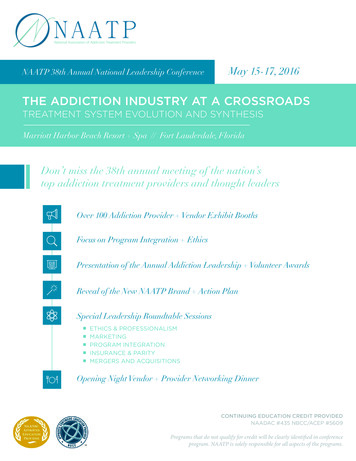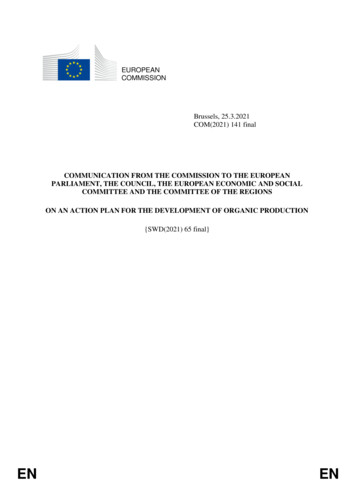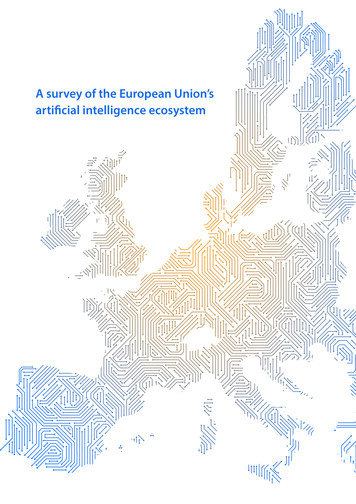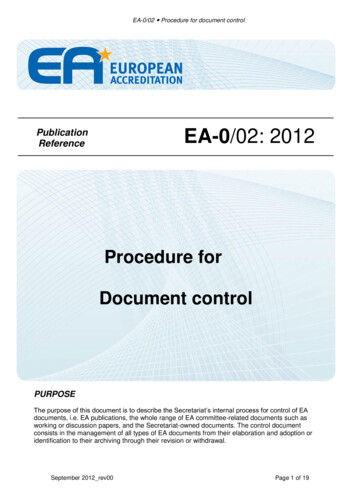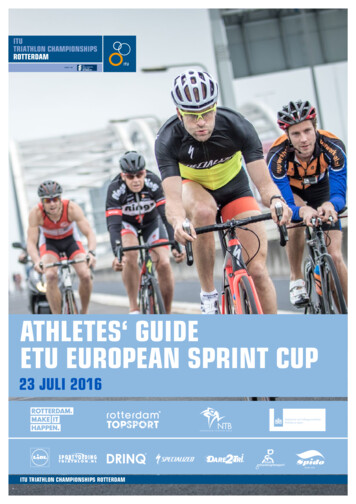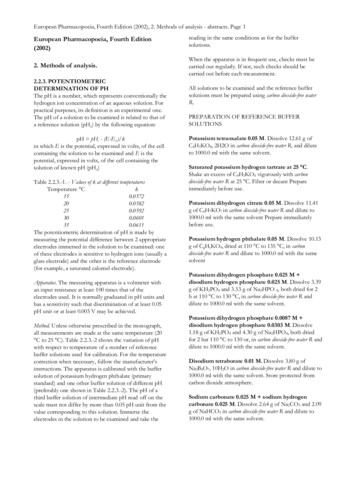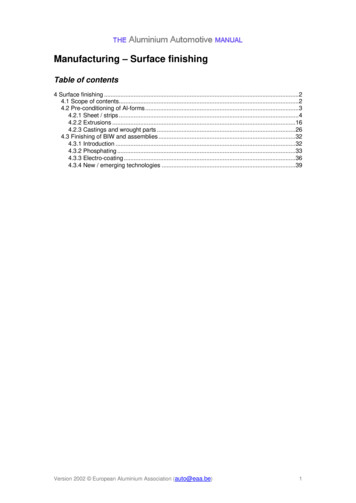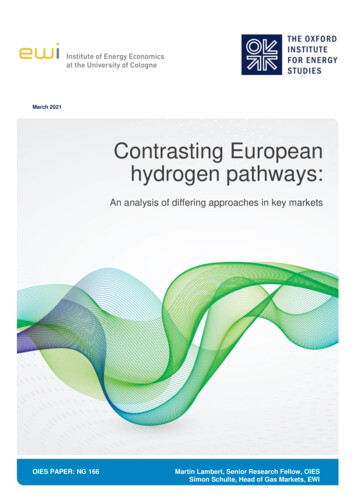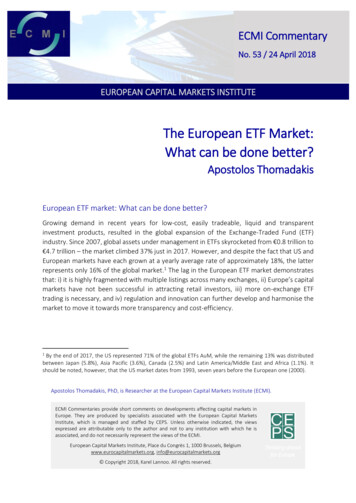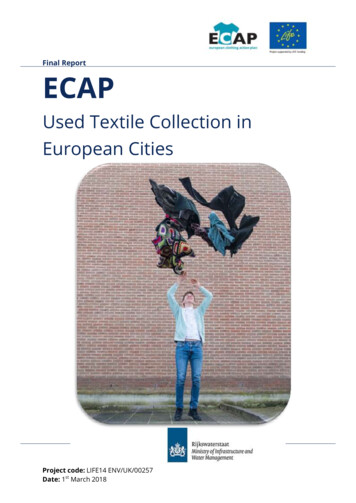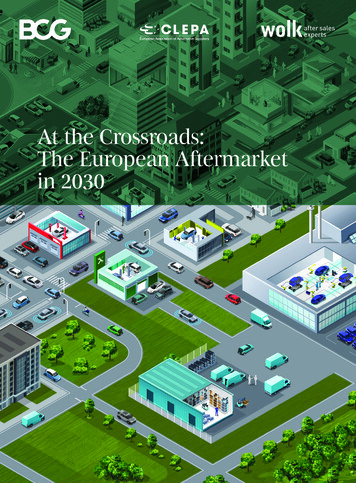
Transcription
At the Crossroads:The European Aftermarketin 2030
Boston Consulting Group partners with leaders in business and societyto tackle their most important challenges and capture their greatestopportunities. BCG was the pioneer in business strategy when it wasfounded in 1963. Today, we help clients with total transformation—inspiring complex change, enabling organizations to grow, buildingcompetitive advantage, and driving bottom-line impact.To succeed, organizations must blend digital and human capabilities.Our diverse, global teams bring deep industry and functional expertiseand a range of perspectives to spark change. BCG delivers solutionsthrough leading-edge management consulting along with technologyand design, corporate and digital ventures—and business purpose. Wework in a uniquely collaborative model across the firm and throughoutall levels of the client organization, generating results that allow ourclients to thrive.CLEPA, the European Association of Automotive Suppliers, is the voiceof the automotive supplier industry in Europe linking the sector topolicy makers in Brussels and Geneva. CLEPA represents over 3.000companies supplying state-of-the-art components and innovativetechnology for safe, smart and sustainable mobility, investing over 30billion euros yearly in research and development. Automotive suppliersdirectly employ about 1.7 million people in Europe. Founded in 1959,our vision is for the automotive supply industry to be the leadingprovider of innovative technologies and solutions for safe, sustainableand smart mobility around the world. Our mission is to co-create theframework conditions for advancing a sustainable and competitivesupply industry in Europe, innovating mobility and bringing prosperityand employment to society at large.Since 1994, Wolk After Sales Experts provides neutral marketinformation, consulting service, and implementation advice exclusivelyin the automotive aftersales market. The basis of our services andproducts is extensive market research and analysis of the globalautomotive aftermarket. We are pooling data with modern methods tosort, filter, and reshape information with the long-term experience andunderstanding of the automotive aftermarket to ensure the best valuefor making the right, future-oriented business decisions.Our experts advise on current trends and help to develop successfulstrategies and concepts and assist in implementing them in the market.We are a neutral partner for any stakeholder in the automotiveaftermarket from the manufacturing industry, buying groups,distribution, Intermediates, mobility concepts up to the car repair shops.Our mission is to assist our clients from research to results for moresuccess in the global automotive aftermarket.
At the Crossroads:The European Aftermarketin 2030Albert Waas, Manfred Beck, Robert Herzberg, Jonas Hauser, Frank Schlehuber,Antti Wolk, and Zoran NikolicMarch 2021
”AT A GLANCEAlthough the 226 billion European aftermarket auto parts business is profitableand growing, market trends and vehicle architecture changes will transform theindustry significantly over the next decade. These trends require competitors tostart mapping strategies now to maintain their market positions in the future.Comprehensive approachIn a wide-ranging study, BCG collaborated with the European Association ofAutomotive Suppliers and Wolk After Sales Experts to identify the challengesthe industry faces and the strategic responses companies should consider. Weconducted more than 30 interviews with aftermarket industry executives and over600 interviews with operators of service centers across Europe.Winning strategiesCompanies must adjust to changing market conditions driven by the industry’sdigitalization, vehicle electrification, and growing channel competition to continuewinning in an increasingly competitive market. Players across the spectrum musttap into the data stream created by the digitalization of automobiles and aftermarket processes. They should carve out a role in increasingly integrated businessalliances that will channel both customers and parts to workshops, and they mustdeal with new competition created by e-tailers and other digital competitors.At the Crossroads: The European Aftermarket Auto Parts Business Faces Greater Competition 2
Prior to the outbreak of the COVID-19 pandemic, the 226 billion Europeanaftermarket auto parts business enjoyed a decade of high margins and steadygrowth in a stable environment. Now the industry must prepare for change onmultiple fronts.A number of trends threaten to slow growth and reduce profit margins over thenext decade. Vehicle architectures are changing to electric drivetrains that requireless maintenance. People are driving less. Driver assistance technology will reducecollisions, and thus the need for replacement parts. New players and digital salestools will increase competition.Although business is bouncing back from the pandemic and will grow both forcompanies in the independent aftermarket and for OEMs and authorized retailers,continued market transformation and increasing competition leave companies at acrossroads. The businesses supplying the independent aftermarket sales channelface the most risk because the growing technological complexity favors automakersand their affiliates.Boston Consulting Group (BCG), in collaboration with the European Association ofAutomotive Suppliers (CLEPA) and Wolk After Sales Experts, an automotive aftermarket consultancy, has examined these dynamics. We conducted more than 30interviews with executives across the aftermarket spectrum to identify 13 trendsthat will shape the European aftermarket over the next decade and developstrategic responses. We followed those discussions with more than 600 interviewswith the operators of service facilities and workshops across Europe.The process identified multiple changes on the horizon in the European aftermarket parts business and the strategic responses companies should consider asthey deal with consolidation at the wholesale level, fleets and insurance companiesproactively routing customers to favored workshops, a regulatory battle over data,and dramatic growth in the private-label parts business.This report examines the European aftermarket asking two key questions: Where toplay? and how to win? The 13 trends it identifies will shape the industry’s size andprofit pools.At the Crossroads: The European Aftermarket Auto Parts Business Faces Greater Competition 3
THE COMPETITIVE ENVIRONMENTCompetition in the European aftermarket auto parts business occurs across twochannels: the authorized channel and the independent aftermarket, or IAM (seeExhibit 1). The authorized channel includes automakers, or OEMs, and theiraffiliated repair shops, typically dealers. Automakers work with Tier-1 suppliers toproduce parts distributed through the OEMs’ sales network that are then used forrepairs and maintenance by authorized workshops.Independent channelAuthorizedchannelEXHIBIT 1 Aftermarket separated into authorized and independent channelsOEM/Tier 1WholesalersVehiclemanufacturersOEM salesand sIntermediariesAuthorized dent repairersIndependent(franchise and non)SpecializedgaragesAuto centersPartmanufacturersCustomer groupsSingle-brandworkshopsInternal procurementof large repair chainsFast fittersOnline distributors& shopsOther utomotive clubsRouting portalsOnline retailersFleets(e.g., petrol stations)Source: BCGThe independent aftermarket is made up of repairers without contractual ties toone vehicle manufacturer. They provide parts and services across multiple brands.Suppliers in this market rely on wholesale distributors to deliver the parts to repairshops. The wholesalers also provide marketing and training support for repairshops. Most of the distributors are part of organizations that function primarily asbuying groups, referred to as international trading groups (ITGs). They allow distributors to group together to negotiate volume purchasing discounts from suppliers.Intermediaries have an increasing presence in the aftermarket, linking playersalong the value chain by routing business. They include service aggregators thatemploy online contact and other means to channel customers to repair facilities.Fleet owners and insurance companies also direct customers to workshops. Agrowing number of customers come under this umbrella, including individual carowners, business fleets, and leasing companies.At the Crossroads: The European Aftermarket Auto Parts Business Faces Greater Competition 4
The authorized and independent channels both sell goods from six broad productcategories. There are wear and tear items such as brake pads, filters, and sparkplugs. Tires make up their own segment. Other parts are items that are typicallyreplaced because of collisions and include body panels, bumpers, glass, and headlights. Another category is powertrain components, including parts for the engine,transmission, and suspension. The final two segment are electronics such asbatteries, sensors, and actuators, and accessories and consumables such as navigation and entertainment units and auxiliary heating.At the Crossroads: The European Aftermarket Auto Parts Business Faces Greater Competition 5
TRENDS THAT WILL TRANSFORM THE MARKETThe trends that will determine the size and competitive nature of the aftermarketauto parts business over the next decade fit into four broad categories (see Exhibit 2).EXHIBIT 2 13 trends shape the European aftermarket until 2030Macroeconomics& regulationCustomer behaviorgrowing and1 Slightlyaging car parcdecreasing8 Moderatelymileage drivendip in 2020,2 COVID-19recovery in 2021power of9 Increasingfleet players & insurersimportance3 Increasingof regulation3TechnologyValue chain & competitioncomplexity drives4 Risingup parts pricespush into10 OEMssegment 2 & 3decreases5 Electrificationmaintenance needprivate labels &11 Morevalue linesconnectivity6 Increasedallows remote car accesspressures12 Consolidationall market participantsof automation (ADAS)7 Risereduces collision rateImpact on aftermarket:Very positiveNeutralVery negativedigital13 Increasingservices & e-commerceMacroeconomic and regulatory environments shiftTrend 1: The car parc is aging and slowly growing. Over the last 10 years, thepassenger car fleet’s average age has risen. The average vehicle in Western Europeis 11 years old; in Central and Eastern Europe it is even older. That has a substantial effect on the repair market, as older vehicles are more likely to need maintenance and replacement parts. The age of the fleet also changes the mix of businessbetween the authorized and independent supply channels. Owners tend to taketheir vehicles to authorized repair shops when they are still under warranty or relatively new. But as their cars age, they are more likely to go to an independent workshop offering cost-effective solutions. That’s especially true for second and thirdowners. In Western Europe, the share of vehicles older than eight years—known assegment 3 cars—increased from 50% in 2011 to 65% in 2019. The industry expectsthat to continue, with the segment 3 share reaching as high as 75% by 2030. Thetrend is even more pronounced in Central and Eastern European countries wherelower disposable income limits new vehicle purchases.At the Crossroads: The European Aftermarket Auto Parts Business Faces Greater Competition 6
The car parc, or number of passenger cars and light commercial vehicles in use inEurope, grew at a 1.6% annual rate from 2011 to 2019, providing one of the maindrivers for expansion in the aftermarket. But with increasing saturation, especiallyin Western Europe’s economies, the rate will fall to less than 1% between 2020 and2025 and slow even more in the latter half of the decade (see Exhibit 3).EXHIBIT 3 Car parc growth projected to slow until '30; share of older cars to increaseCAGRCar parc (PC & LCV), split by region(M units)'11-'191 HistoricalStrong growth'19-'252 ForecastModerate growth51% 53% 55% 58% 60% 62% 63% 63% 64%'25-'303 ForecastSlow growth65-70%342 344327 333 336 33930 302929292843 45 46 46 47 48346 348 350 352 35530 31 31 32 3248 49 49 50 50249 251 254231 233 234 237 240 244256 260 262 263 265 266267 269 270 271 2722011 2012 2013 2014 2015 2016 2017 2018 20192020 2021 2022 2023 2024 20252026 2027 2028 2029 2030316 320 325298 303 30927 28287 293 29626 27 2722 25 26 2642 4340383734 34 35 36Western EuropeCentral 9%1.6%65-75%1Eastern EuropeNote: Eastern Europe countries include Belarus, Bosnia-Herzegovina, Bulgaria, Cyprus, Estonia, Greece, North Macedonia, Ukraine; Central Europeincludes Croatia, Czech Republic, Hungary, Latvia, Lithuania, Poland, Romania, Serbia, Slovakia, Slovenia; Western Europe includes Austria, Belgium,Denmark, Finland, France, Germany, Iceland, Ireland, Italy, Luxembourg, Netherlands, Norway, Portugal, Spain, Sweden, Switzerland, UnitedKingdom; forecast of segment 3 share indicativeSource: IHS; Wolk; Market participant interviews; BCG analysisTrend 2: COVID-19 is accelerating changes. Shocks such as economic downturnsand the COVID-19 pandemic accelerate overall change in the aftermarket. Job concerns and the recession arising from the pandemic have reduced new car purchases,further aging the existing fleet. The aftermarket business felt less of an effect. Itsuffered a 50% decline during the lockdowns of March and April of last year butbounced back quickly, ending 2020 down only around 7%. It is expected to recoverto pre-pandemic levels in 2021. But the competitive environment has changed.Fewer new vehicle sales and rising average car ages favor the independent aftermarket, allowing it
600 interviews with operators of service centers across Europe. Winning strategies Companies must adjust to changing market conditions driven by the industry’s digitalization, vehicle electrification, and growing channel competition to continue winning in an increasingly competitive market. Players across the spectrum must
